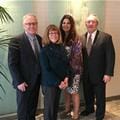Decoding BOMA/Chicago’s Codes Committee
By Bill Vail, CA Ventures and Janice Goldsmith, Zeller Realty Group
 From left to right: Codes Committee Chair and Vice Chair Bill Vail and Janice Goldsmith, Building Commissioner Judith Frydland and Executive Vice President Michael Cornicelli
From left to right: Codes Committee Chair and Vice Chair Bill Vail and Janice Goldsmith, Building Commissioner Judith Frydland and Executive Vice President Michael Cornicelli
There are plenty of ways we talk about collaboration. “Playing nicely in the sandbox”, “a team effort”, or “all hands on deck” are a few.
These buzzwords unfortunately oversimplify the fact that collaborating can be challenging. Different points of view, contrary interests or even clashing personalities can often derail it, making it difficult to get things done.
On the flipside is good collaboration. It involves listening, openness and having shared values and goals. Things not only get done, they exceed expectations because everyone is contributing. Fortunately, the BOMA/Chicago Codes Committee sits firmly in the second camp.
Our work is deeply collaborative. When it comes to building codes and overall safety, everyone is on the same page. We’re partners, not adversaries. We all work together, and work toward the same goal: enhancing building safety and operations in Chicago.
Codes Committee members work closely with each other, but we also collaborate with other BOMA/Chicago committees, the Chicago Department of Buildings and a number of additional local municipal entities. We stay attuned to all things codes and facilitate productive ongoing conversations. Keeping vendors and owners involved throughout these discussions ensures our buildings remain safe.
For example, we’re working closely with the BOMA/Chicago Preparedness Committee to ensure fire life safety. We also brought in local departments to help with the initiative, including the Chicago Fire Department, Chicago Police Department and the Office of Emergency Management and Communication.
This collaboration allowed us to influence the redevelopment of the City’s Fire Safety Director program into one that promotes education and safety in a more feasible format for property management teams to implement. As a result of our combined efforts, there are thousands more fire life directors trained and certified since the new format we developed was adopted. In turn, our buildings are safer.
A true testament to our work, membership of the committee has grown throughout the past few years. The Committee consists of building members as well as affiliates from architectural, engineering and fire safety firms. They’re experts in translating city codes and provide valuable insights into how they impact our buildings.
And we’ve been busy.
Codes affect the success of commercial buildings, and also their bottom line. Our committee has a keen understanding of what existing codes and proposed changes mean for our members, how they should react and stay competitive in the marketplace. This all contributes to our buildings being leaders in the space on a national level.
One of our top priorities right now is the International Building Code (IBC). Chicago attracts architects and engineers throughout the world, yet we’re the only major city that does not use the IBC model. Architects and engineers want to understand the required codes in every city, including Chicago, and incorporating IBC puts us on a path of clearer interpretation. If we incorporate IBC into Chicago’s codes, Chicago becomes even more of an international city than it already is.
While it’s difficult to quantify the exact cost-savings the IBC will bring, we’re confident BOMA/Chicago members will feel it. For example, when the city adopted a new electric code based on the IBC, there were savings from allowing different elements and materials to be used in the building.
We’re proud to be working hand in hand with the Chicago Department of Buildings to incorporate the IBC. They would like to implement parts of the IBC, keep some of the Chicago code where necessary and blend these where it makes sense. This will help Chicago develop buildings faster while staying on top of what’s happening on an international basis.
The city will roll out the IBC implementation, and we will be directly involved every step of the way. We will review the changes, find clarity and provide feedback and recommendations when necessary. Part of this involves looking at the changes from a practical point-of-view and educating our members on what it means for them. We’ll help make the transition from Chicago code to IBC as seamless as possible. We know it won’t be perfect, but we will be hands-on during the entire process.
We applaud the Chicago buildings commissioner, Judith Frydland, for all her hard work in moving Chicago to the IBC. We will work diligently with her and her staff to provide information in a concise and helpful manner.
To that end, deputy commissioner Grant Ullrich with the Chicago Buildings Department has also been monumental in helping us solve issues and clear up misconceptions first-hand by regularly attending our meetings. This dialogue with members has been received with much enthusiasm, and we’re grateful.
Without collaboration, it would have been difficult to get any of these projects done. Thankfully, the codes committee has been able to get a lot accomplished by working together. The benefits of our collective work can be felt every time you step into an office building in Chicago. We got there by relying on the expertise of our colleagues each and every day – and we will do it again tomorrow, too.
Bill Vail is the Chair of the BOMA/Chicago Codes Committee and Janice Goldsmith serves as the Vice Chair.

